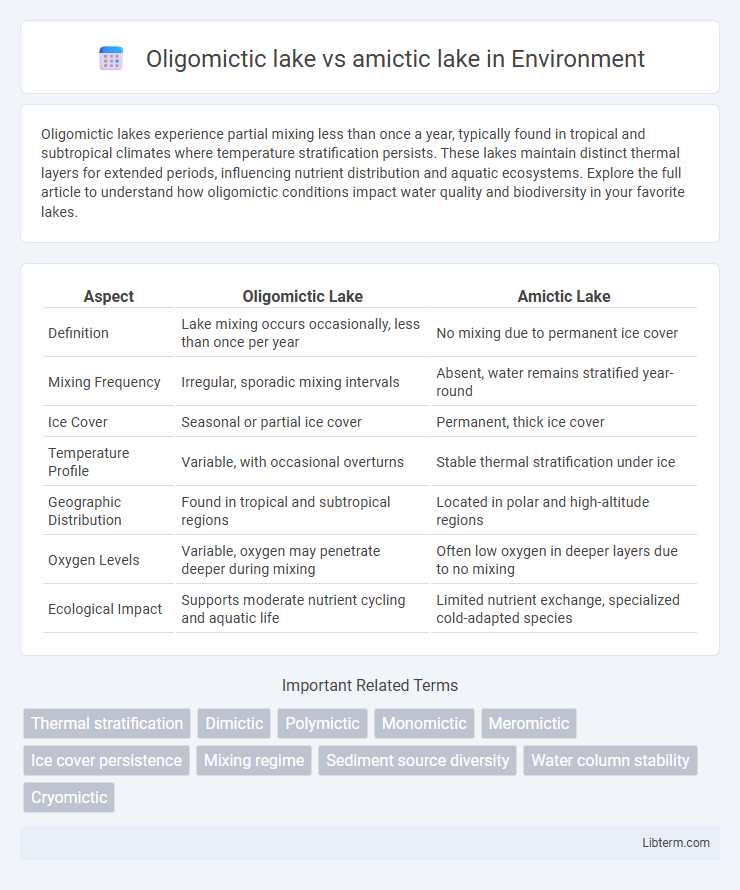Oligomictic lakes experience partial mixing less than once a year, typically found in tropical and subtropical climates where temperature stratification persists. These lakes maintain distinct thermal layers for extended periods, influencing nutrient distribution and aquatic ecosystems. Explore the full article to understand how oligomictic conditions impact water quality and biodiversity in your favorite lakes.
Table of Comparison
| Aspect | Oligomictic Lake | Amictic Lake |
|---|---|---|
| Definition | Lake mixing occurs occasionally, less than once per year | No mixing due to permanent ice cover |
| Mixing Frequency | Irregular, sporadic mixing intervals | Absent, water remains stratified year-round |
| Ice Cover | Seasonal or partial ice cover | Permanent, thick ice cover |
| Temperature Profile | Variable, with occasional overturns | Stable thermal stratification under ice |
| Geographic Distribution | Found in tropical and subtropical regions | Located in polar and high-altitude regions |
| Oxygen Levels | Variable, oxygen may penetrate deeper during mixing | Often low oxygen in deeper layers due to no mixing |
| Ecological Impact | Supports moderate nutrient cycling and aquatic life | Limited nutrient exchange, specialized cold-adapted species |
Introduction to Lake Mixing Types
Oligomictic lakes experience partial mixing during warmer months, with water stratification breaking down infrequently, typically only in specific climatic conditions or regions with mild temperature fluctuations. Amictic lakes remain permanently ice-covered, preventing mixing and causing the water column to remain largely stagnant and stratified year-round. Understanding these lake mixing types is essential for studying aquatic ecosystems, nutrient cycling, and temperature profiles in diverse environmental settings.
Definition of Oligomictic Lakes
Oligomictic lakes are characterized by infrequent mixing of water layers, typically occurring less than once per year, due to their stable thermal stratification in tropical or subtropical climates. In contrast, amictic lakes remain permanently stratified and never undergo complete mixing, often because of continuous ice cover in polar regions. The limited mixing in oligomictic lakes affects nutrient cycling and oxygen distribution, influencing their unique ecological dynamics compared to amictic lakes.
Definition of Amictic Lakes
Amictic lakes are water bodies that remain permanently ice-covered, preventing any mixing of the water column throughout the year. Unlike oligomictic lakes, which experience occasional mixing during brief warming periods, amictic lakes maintain stable stratification due to continuous ice cover and minimal temperature variation. These lakes are typically found in polar regions where harsh cold conditions inhibit seasonal turnover and nutrient circulation.
Key Physical Characteristics
Oligomictic lakes typically mix once or twice annually due to partial temperature stratification and limited seasonal ice cover, whereas amictic lakes remain permanently ice-covered, preventing any mixing throughout the year. Oligomictic lakes experience variable thermal stratification influenced by climatic conditions, while amictic lakes maintain a stable, stratified water column beneath ice, often found in polar or high-altitude regions. The presence or absence of ice and seasonal temperature fluctuations fundamentally distinguishes the mixing regimes and thermal profiles of these lake types.
Temperature and Seasonal Stratification
Oligomictic lakes experience infrequent or partial mixing, often maintaining stable thermal stratification for most of the year with temperature gradients disrupted only briefly during rare cooling periods. Amictic lakes remain permanently ice-covered, preventing any seasonal stratification and temperature changes within the water column throughout the year. Temperature profiles in oligomictic lakes show episodic mixing events, whereas amictic lakes maintain stable, cold temperatures beneath ice with no turnover.
Geographic Distribution
Oligomictic lakes predominantly occur in tropical and subtropical regions where temperature stratification is stable, resulting in limited mixing events usually once every few years. Amictic lakes are primarily found in polar and alpine regions, characterized by permanent ice cover that prevents mixing and maintains a consistent stratification year-round. Geographic distribution of these lakes is closely tied to climatic conditions, with oligomictic lakes in warmer climates and amictic lakes in cold, ice-covered environments.
Ecological Impacts and Biodiversity
Oligomictic lakes experience periodic mixing, which enhances oxygen distribution and nutrient cycling, supporting diverse aquatic ecosystems and promoting higher biodiversity compared to amictic lakes. Amictic lakes remain permanently stratified, often leading to oxygen-depleted deeper layers that limit habitat availability and reduce species richness. The contrasting mixing regimes significantly influence ecological processes, with oligomictic lakes fostering more dynamic habitats conducive to sustaining complex food webs and ecosystem resilience.
Water Quality and Oxygen Levels
Oligomictic lakes, which mix irregularly, often experience variable oxygen levels that support diverse aquatic life, but may develop low oxygen zones in deeper layers during stratification. Amictic lakes remain permanently ice-covered, limiting oxygen replenishment and frequently resulting in hypoxic or anoxic conditions beneath the ice, negatively impacting water quality and aquatic organisms. Water quality in oligomictic lakes tends to be higher due to periodic mixing that redistributes oxygen and nutrients, whereas amictic lakes face challenges in maintaining oxygenated conditions year-round.
Human and Environmental Significance
Oligomictic lakes undergo occasional mixing, which improves oxygen distribution and nutrient cycling beneficial for aquatic life and human water uses such as fishing and recreation. Amictic lakes remain permanently ice-covered, limiting biological productivity but serving as critical climate indicators and preserving unique ecosystems vulnerable to climate change. Both lake types influence local biodiversity, water quality, and regional climate regulation, affecting human communities dependent on their ecological services.
Comparing Oligomictic vs Amictic Lakes
Oligomictic lakes mix sporadically, typically once every few years, due to limited temperature fluctuations, while amictic lakes remain permanently ice-covered and do not undergo mixing. Oligomictic lakes support diverse aquatic life owing to periodic oxygenation throughout the water column, whereas amictic lakes often experience oxygen depletion beneath the ice, restricting biological activity. Temperature regimes and ice cover duration are key factors differentiating oligomictic lake stratification and amictic lake stability.
Oligomictic lake Infographic

 libterm.com
libterm.com